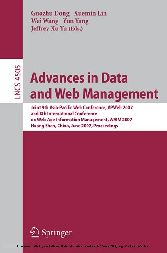Search and Find
Service
More of the content

Advances in Data and Web Management - Joint 9th Asia-PacificWeb Conference, APWeb 2007, and 8th International Conference on Web-Age Information Management,WAIM 2007
Process Aware Information Systems: A Human Centered Perspective (p. 60)1 Introduction
A Process Aware Information System (PAIS) is a software system that manages and executes operational processes involving people, applications, and/or information sources on the basis of an explicit imbedded process model. The model is typically instantiated many times, and every instance is typically handled in a predefined way. Thus this definition shows that a typical text editor is not process aware, and likewise a typical e-mail client is not process aware.
In both of these examples, the software is performing a task, but is not aware that the task is part of a process. Note that the explicit representation of process allows automated enactment, automated verification, and automated redesign, all of which can lead to increased organizational efficiency. Other potential benefits of PAIS are elaborated in [1].
An increasingly large population of diverse humans is interacting with technology these days, it is therefore increasingly important for computerized systems to address issues of human interaction / collaboration. The incorporation of process into information systems is particularly challenging because most PAIS involve processes performed by people. People processes are complex, semi-structured, and dynamically changing. Within PAIS design, it is thus necessary to take into account factors that impinge upon the organizational structures, the social context, the cultural setting, and other dimensions.
This paper first introduces examples and concepts of collective endeavors noting characteristics that can be quite challenging to capture within process descriptions. In the following sections, a framework for analysis, enactment, and mining is described, then a multidimensional meta-model is introduced. The paper ends with summary and conclusions.
2 Collective PAIS Environments
This section discusses issues related to collective endeavors in a broad sense. It introduces the complexity and variability of collective group interactions through examples, and discusses how structure can be identified in these interactions. It remains true that "how people work is one of the best kept secrets" (David Wellman, cited by Suchman [18]). Collective work is characterized by its fluidity and complex weaving of organizational, social, political, cultural and emotional aspects. Interaction at work takes a wide variety of forms. Consider for instance the following examples:
Extreme Collaboration. Mark[12] describes a "war room" environment employed by the NASA’s Jet Propulsion Laboratory (JPL) to develop complex space mission designs in a very short time—nine hours over a single week for a complete and detailed mission plan. During these interaction sessions, sixteen specialists are physically co-located in a room that contains a network of workstations and public displays.
Collaboration is prompted by a complex combination of physical awareness, by monitoring of the parallel conversations in the noisy environment and in response to data that is published through customized networked spreadsheets that allow team members to publish data they produce and subscribe to data published by others. Team members move around the room to consult other specialists, or .ock to the public display to discuss problems of their interest.
All prices incl. VAT











